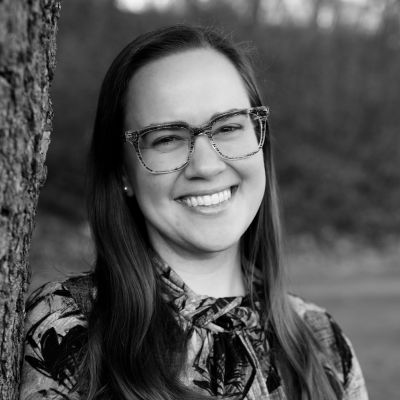
Sara Weir
Park View Middle School
Cranston, Rhode Island
Sara Weir’s influence on the Cranston community in Rhode Island is far-reaching. In addition to her position as a music teacher at Park View Middle School where she incorporates technology and innovative manipulatives to help her students learn, she has developed a community choir and a district-wide symphony orchestra!
Weir’s general music students in 7th and 8th grade learn about technology as well as music. They use supplemental instructional apps like Youcisian or YouTube tutorials in between direct or one-on-one instruction on ukulele, guitar and piano. Additionally, Weir’s classes do a Foley Art lesson where students record everyday sounds using CapCut and Vocaroo and layer them over a short film. “I love this lesson because students get to see the history of sound effects from when it was mostly physical objects and the progression to using digital sounds and keyboard sound effects,” she says.
Weir’s music program is built on relationships between students. “We work together in class as a team to learn, and then eventually perform,” she explains. “Students teach each other, and students get to have choices in what pieces we perform. We try to have hands-on activities and instruments for all our classes. If we don’t have the physical instrument, we utilize as much technology as we can.”
In addition to the use of cutting-edge tech, Weir also goes “old school” by using several different manipulatives to help her strings students with bow holds. “Our school can’t afford the silicone bow-hold aids for all my students, so I went online and found a YouTube video on how to make ‘pinky houses,’” she explains. “The kids love the name, and the flexibility of the tape allows students to build the muscles with help. In time, the tape comes off, and they are ready to play. I see an improvement each year, as students begin to master the fine motor skills.”
Manipulatives are also used in Weir’s band class, where flute, clarinet and saxophone players create pencil instruments and use a Sharpie to mark dashes for the keys. “It’s very compact (travel sized!) but allows students to practice fingerings on a smaller scale before transferring the skill to their larger instrument. It also makes for a handy replacement when they forget their instrument,” she says.
While working on her master’s degree in education leadership and policy from Boston University, Weir decided to create a community choir to fulfill the community engagement part of her practicum requirements. “I felt that a community choir would be a great way to bring all ages and levels together to sing and heal, post COVID,” she says. “I had a few goals: 1) sing as much as possible, no matter what; and 2) to use movement and mindfulness to connect with our bodies and voices.”
Weir plans to facilitate and aid the community choir in whatever way she can, both as a member of the community and as a Cranston Public Schools representative and educator. “We would like to expand our programming and do more than one performance this spring,” she says.
In addition to the community choir, Weir also started a district-wide symphony orchestra. “When I attended Cranston schools as a child, we didn’t have orchestra or strings past 8th grade,” she says. “When a graduating high school senior (who was headed to the University of Rhode Island) reached out to me over the summer and asked me to help him continue the symphonic orchestra he was running at his school, I said yes! We could combine our dreams — his of conducting original symphonic works and mine of creating a community space.”
The Cranston Symphonic Orchestra features students in grades 7-12 from the four middle and two high schools. In addition to performing original and arrangements of master symphonic works, Weir encourages and provides support on auditions and music from other community groups. Students rehearse for two hours every week and will perform several concerts this year, as well as guest perform at several others to help with recruitment. “It’s an excellent chance for students to build a social network across the city,” Weir says.








